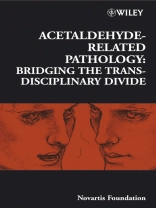Part of the prestigious Novartis Foundation, this is the first book
to review the pathology associated with acetaldehyde, a known toxic
agent found in cigarette smoke and other pollutants and derived
from ingested alcohol, amongst other sources. In the body,
acetaldehyde affects several tissues, particularly the brain and
liver, causing various diseases, including cancer, alcoholic liver
disease and Alzheimer’s.
Acetaldehyde-Related Pathology describes the toxic
effects of acetaldehyde at the tissue and cellular levels,
reviewing enzyme biochemistry, transgenic mouse models of alcohol
dehydrogenase mutants, and the cell-signalling pathways implicated
in alcohol-related pathology. It explores the mechanisms of
acetaldehyde-induced damage to tissues, often a first step in
carcinogenesis, including the oral cavity, the human airway, and
the GI tract. The book considers pharmacological strategies and
treatments for reducing oral and intestinal acetaldehyde.
Acetaldehyde-Related Pathology features in-depth,
round-table discussions by an international array of scientists
from major laboratories worldwide involved in studies of
acetaldehyde-related pathology.
This book is essential reading for anyone interested in the
effects of this compound – pathologists, biochemists,
toxicologists, cell and molecular biologists.
Tabella dei contenuti
Symposium on Acetaldehyde-related pathology: bridging the trans-disciplinary divide, held at the Novartis Foundation, London 5-7th September 2006
Editors: Derek J. Chadwick (Organizer) and Jamie Goode
This symposium is based on a proposal made by Victor Preedy, Peter Emery and Mikko Salaspuro
Peter Emery Chair’s introduction 1
David W. Crabb and Suthat Liangpunsakul Acetaldehyde generating enzyme systems: roles of alcohol dehydrogenase, CYP2E1 and catalase, and speculations on the role of other enzymes and processes 4
Discussion 16
Richard A. Deitrich, Dennis Petersen and Vasilis Vasiliou Removal of acetaldehyde from the body 23
Discussion 40
Shih-Jiun Yin and Giia-Sheun Peng Acetaldehyde, polymorphisms and the cardiovascular system 52
Discussion 63
Jun Ren Acetaldehyde and alcoholic cardiomyopathy: lessons from the ADH and ALDH2 transgenic models 69
Discussion 76
Mikko Salaspuro Interrelationship between alcohol, smoking, acetaldehyde and cancer 80
Discussion 89
Hiroto Matsuse, Chizu Fukushima, Terufumi Shimoda, Sadahiro Asai and Shigeru Kohno Effects of acetaldehyde on human airway constriction and inflammation 97
Discussion 106
Helmut K. Seitz The role of acetaldehyde in alcohol-associated cancer of the gastrointestinal tract 110
Discussion 119
Robert Tardif The determination of acetaldehyde in exhaled breath 125
Discussion 133
Mostofa Jamal, Kiyoshi Ameno, Mitsuru Kumihashi, Weihuan Wang, Ikuo Uekita and Iwao Ijiri Ethanol and acetaldehyde: in vivo quantitation and effects on cholinergic function in rat brain 137
Discussion 141
Ville Salaspuro Pharmacological treatments and strategies for reducing oral and intestinal acetaldehyde 145
Discussion 153
Victor R. Preedy, David W. Crabb, Jaume Farrés and Peter W. Emery Alcoholic myopathy and acetaldehyde 158
Discussion 177
Onni Niemelä Acetaldehyde adducts in circulation 183
Discussion 193
General discussion 198
M. Apte, J. Mc Carroll, R. Pirola and J. Wilson Pancreatic MAP kinase pathways and acetaldehyde 200
Discussion 211
Shivendra D. Shukla, Youn Ju Lee, Pil-hoon Park and Annayya R. Aroor Acetaldehyde alters MAP kinase signalling and epigenetic histone modifications in hepatocytes 217
Discussion 224
Paul J. Thornalley Endogenous ?’-oxoaldehydes and formation of protein and nucleotide advanced glycation endproducts in tissue damage 229
Discussion 243
C. J. Peter Eriksson Measurement of acetaldehyde: what levels occur naturally and in response to alcohol? 247
Discussion 256
Final discussion 261
Contributors Index 265
Subject index 267
Circa l’autore
The Novartis Foundation is an international scientific and
educational charity which promotes the study and general knowledge
of science and in particular encourages international co-operation
in scientific research.
Chairman: Peter Emery












